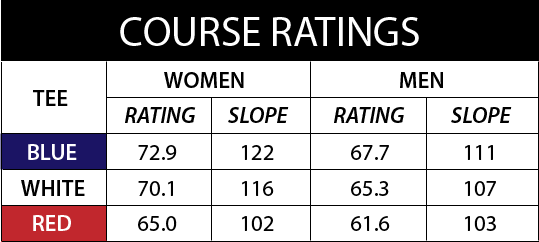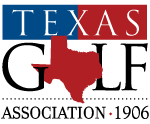Course Rating Overview
 When first established, the Course Rating system identified the difficulty of a course as it would be played by the scratch golfer. This is called a Course Rating and is a number rounded to one decimal place (example 70.1). Since the scratch golfer usually hits the ball relatively straight, obstacles such as trees, water, sand, etc., are of little influence, leaving effective playing length of the course as the major difficulty factor.
When first established, the Course Rating system identified the difficulty of a course as it would be played by the scratch golfer. This is called a Course Rating and is a number rounded to one decimal place (example 70.1). Since the scratch golfer usually hits the ball relatively straight, obstacles such as trees, water, sand, etc., are of little influence, leaving effective playing length of the course as the major difficulty factor.
It eventually became evident that it was necessary to also identify the difficulty of a course for the bogey golfer since courses of similar effective playing length could vary widely in the number and severity of obstacles present. In 1987, the USGA introduced the Slope System as a means of evaluating both length and obstacles as the difference in difficulty between the scratch and bogey golfer.
The Slope Rating of a golf course is a whole number between 55-155, which indicates the relative difficulty of a course for the bogey golfer compared to the scratch golfer. In simple terms, the higher the Slope Rating, the more strokes the golfer with a higher handicap needs from the golfer with lower handicap.
To accomplish maintaining current ratings for the thousands of golf courses in this country, the USGA has trained local and Regional Golf Associations in the USGA Course Rating System and supplied them with materials to make the resulting ratings accurate and consistent. With the tremendous increase in inter-club play, this consistency and accuracy has become more and more important. The TGA rates Member Club courses in accordance with the United States Golf Association (USGA) Course and Slope Rating System. The USGA requires that all new golf courses be re-rated after five years. All courses must be re-rated every 10 years. When a golf course is rated, the rating team evaluates the overall difficulty of the golf course by taking into account the 10 obstacles and effective length corrections on every hole. They give a numerical evaluation of all obstacles on each hole – topography, fairway, green target, rough and recoverability, bunkers, crossing penalty areas, lateral penalty areas, trees, green surface, and psychological effects – and use those numbers to calculate a rating. Members of the team will usually play the course before or after the rating to gain more insight into the course’s level of difficulty. Utilizing regional teams of raters located throughout Texas, the TGA rates approximately 75 to 100 courses annually. Precise course and slope ratings are provided for each set of tees, so that all golfers can enjoy the benefits of an accurate and equitable handicap system.
When a golf course is rated, the rating team evaluates the overall difficulty of the golf course by taking into account the 10 obstacles and effective length corrections on every hole. They give a numerical evaluation of all obstacles on each hole – topography, fairway, green target, rough and recoverability, bunkers, crossing penalty areas, lateral penalty areas, trees, green surface, and psychological effects – and use those numbers to calculate a rating. Members of the team will usually play the course before or after the rating to gain more insight into the course’s level of difficulty. Utilizing regional teams of raters located throughout Texas, the TGA rates approximately 75 to 100 courses annually. Precise course and slope ratings are provided for each set of tees, so that all golfers can enjoy the benefits of an accurate and equitable handicap system.
Whether or not you are a TGA Member Club, if your course is due to be re-rated, please contact Shona DeMint at 972-685-1292 or via email at [email protected] for more information.



